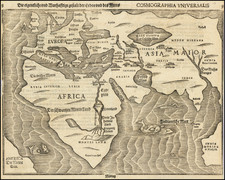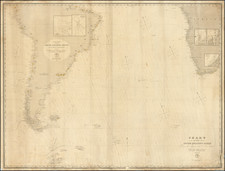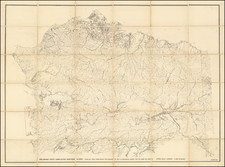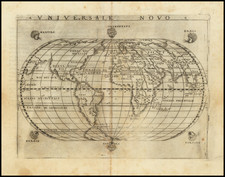Nazi Propaganda for Germany's U-Boot War
Issued by the Nazi propaganda machine at the height of World War II, this large-format broadside depicts more than 1200 successful U-boat attacks on Allied vessels in 1942. The year-long campaign terrorized British and American ships seeking to provide a struggling England with much-needed materials and supplies.
The piece shows three different maps, each depicted as a view of the globe but focusing on the Atlantic. The first map (left) shows the result of the Nazi U-boat campaign between January and April 1942. The associated explanatory text underlines that German U-boats sunk 287 steamships sunk during this period. The middle map depicts the campaign from May until the end of July, during which 364 steamers were destroyed. And finally, on the right, a third map shows the 557 successful engagements from August until December of that fateful year.
The total number of steamships sunk by the German u-boat forces was a shocking 1208 vessels during 1942.
The map on the left represents the first months following the United States' formal entry into the war, the triggering cause being the attack on Pearl Harbor in early December of 1941. In the following months, German U-boats surprised the American Navy and government by carrying out intensive submarine attacks on merchant and transport vessels along the East Coast. In the text below the map, this zone is identified as the Allied "soft spot" (weiche Stelle) because submarine attacks were stymieing the flow of goods and material from American production centers to Europe's last great bastion: England. Germany's focus on the American East Coast is palpable in the first map, which sees a swarm of engagements on the U.S. coast. Additional engagement symbols are found in the Caribbean, along the South American coast, and off West Africa.
The mapmaker marks the German presence during this initial phase of submarine attacks with three thick black arrows emanating from France (also indicating just how much of Europe the Nazis already controlled at this stage). The numbers are explained in the text beneath the map, which specifies the number of vessels sunk and that the enemy had lost almost 2 million tonnes (BRT or Bruttoregistertonne) of needed supplies and material during the first four months of the year.
By April, the combined defensive efforts of the British and the Americans had made attacks off the American East Coast untenable. And so, new zones of engagement had to be discovered. This new phase is portrayed in the second (middle) map. One immediately notes a shift in location and number of engagements. Since the first four months of the year, the number of successful military engagements appears to have risen from 287 between January and April to 364 between May and July.
The third map illustrates German efforts during the last five months of 1942. The distribution of the attacks has changed significantly, revealing how rapidly the war was progressing at this stage. Engagements now cluster in the North Atlantic, with secondary zones of engagement in the outer Caribbean, off the north and east coast of Brazil, and for the first time, in the Mediterranean and around the Cape of Africa. A fifth conflict zone is found in the Arctic waters north of Scandinavia. Interestingly, the origin of some of the German forces has expanded to include not just France but also occupied Norway. The map and the associated text below make it clear that during 1942, Germany's U-boat warfare went from a U.S. focused harassment of predominantly mercantile vessels to a global engagement with anyone providing support to the Allies.
Issued in 1943, this broadside was produced when Germans remained confident of victory. Yet 1942 was also when the tides of war slowly began to turn. The formal U.S. involvement and Hitler's growing losses along the eastern front would eventually be decisive contributors to the regime's downfall. But at this stage, nothing was yet certain, and the sheer military power that Germany wielded is reflected in the numbers that this map totes. As such, the map reflects a particularly dramatic period in the history of World War II.
Bilder der Woche was a popular German magazine published weekly by the Oberkommando des Heeres Verlag (i.e. the Supreme Command of the Army) and printed by August Scherl and the Scherl Bilderdienst in Berlin.











![(Second World War - Prelude - German Irredentism) Die Zerstuckelung Deutschlands. Vom Reiche sollen in Ost und West 5 1/2 Millionen Deutsche getrennt werden! [The Dismemberment of Germany. East and West, 5-1/2 Million Germans Are to be Separated from the Nation] (Large Edition)](https://storage.googleapis.com/raremaps/img/small/94725.jpg)




![Amer. Sep. No. 19 & 20 [Partie du Groenland and Groenland Orientale]](https://storage.googleapis.com/raremaps/img/small/19107.jpg)